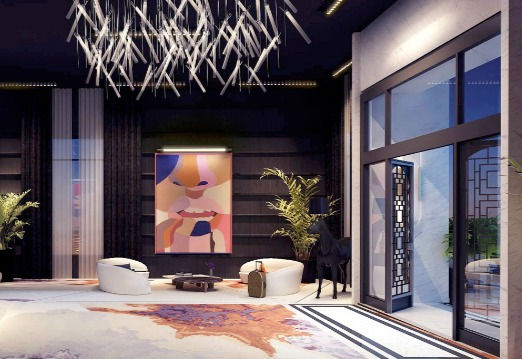Artful Hospitality: Elevating Design Through Thoughtful Art Selection
- Drake+Khan Design

- Mar 4, 2024
- 3 min read
© Drake + Khan Design / The Mila Hotel
In the realm of hospitality design, every element within a space plays a crucial role in shaping the guest experience. From the layout of the lobby to the choice of furnishings in guest rooms, every detail contributes to the overall ambiance and atmosphere. One element that holds particular significance is the selection of art pieces.
Creating a Memorable Experience:
©Studio Munge / The Bisha Hotel
In a competitive hospitality landscape, creating a memorable and immersive environment for guests is paramount. Art serves as a powerful tool in achieving this goal.
Thoughtfully selected art pieces can evoke a sense of wonder, intrigue, and delight, leaving a lasting impression on guests long after they've checked out. Whether it's a striking sculpture in the lobby, a vibrant mural in the restaurant, or a collection of photographs in the guest rooms, art adds depth and character to the space, elevating the overall guest experience.
Reflecting Brand Identity:
© Wang Ting Photography / LDH Architectural Design / Shanghai Zi Fu Hui
Art can also serve as a reflection of the hotel's brand identity and values. Whether it's a boutique hotel with a focus on contemporary art or a luxury resort showcasing local craftsmanship, art can reinforce the brand narrative and create a sense of authenticity and connection with guests. By selecting pieces that resonate with the brand's ethos and aesthetic, hoteliers can create a cohesive and immersive space that reinforces brand loyalty and enhances the overall guest experience.
Fostering Ambiance and Atmosphere:
© Fairmont & Vesper Residences Moscow / Irina & Olga Sundukovy / Yana Popok / Olga Sasykina / Olga Soinova, Anton Brystov
One of the most significant contributions of art to hospitality design is its ability to foster ambiance and atmosphere. Art has the power to evoke a wide range of emotions, from tranquility and relaxation to excitement and inspiration. By carefully curating pieces that align with the desired mood and ambiance of the space, designers can create a multi-sensory experience that engages guests on a deeper level.
Real World Examples:
The 21c Museum Hotel - Various Locations
© TenBerke Architects / 21c Museum Hotel, Kentucky
The 21c Museum Hotel chain seamlessly blends contemporary art with luxury hospitality. Each location features curated art collections that reflect the local culture and community, fostering a unique ambiance in each property. For example, at the 21c Museum Hotel in Louisville, Kentucky, guests encounter a multitude of dual exposure, monochrome paintings, setting a playful and artistic tone for the experience.
Hotel Hotel - Canberra, Australia
Hotel Hotel in Canberra is renowned for its innovative approach to hospitality design, where art is integrated into every aspect of the guest experience. The hotel features an eclectic mix of art installations, sculptures, and murals created by local and international artists. For instance, the lobby showcases a striking installation made from salvaged timber, evoking the rugged beauty of the Australian landscape.
The Silo Hotel - Cape Town, South Africa
The Silo Hotel in Cape Town is situated in a converted grain silo complex, where industrial heritage meets contemporary design. Art plays a central role in defining the hotel's ambiance, with the centerpiece being the Zeitz Museum of Contemporary Art Africa (MOCAA) located within the same building. The hotel's interior design seamlessly integrates artworks from the museum's collection, creating a dialogue between historic architecture and modern art.
Conclusion:
In hospitality design, the selection of art pieces is not merely an aesthetic consideration but a strategic decision that can profoundly impact the guest experience. By carefully curating art collections that resonate with the brand's ethos and enhance the desired ambiance of the space, hoteliers, designers, and curators can create truly transformative experiences that leave a lasting impression on guests.











Comments